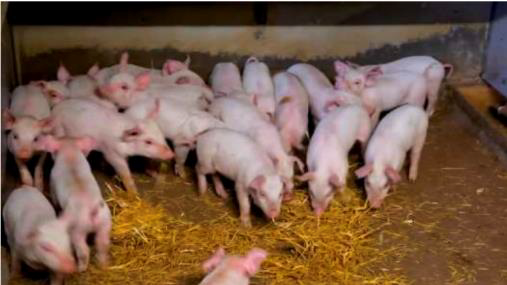Abstract: More and changing rooting material
Type and Average of Pigs on the Farm
The farm maintains approximately 600 sows, 2,800 weaners, and 150 grower-finishers.

Farming System
The production system is intensive, with no use of extensive, organic, or free-range methods.
Description and Evaluation of the Good Practice
The practice involves monitoring pigs for early signs of tail biting (e.g., small wounds, hanging tails) and responding by increasing the quantity and variety of rooting materials. Materials such as straw and beet pellets are used to redirect pigs’ natural exploratory behavior away from pen mates. This approach has proven effective in preventing outbreaks and reducing the severity of tail injuries. It is simple to implement, requiring only that materials be kept in stock and distributed as needed. The practice improves animal welfare by fulfilling behavioral needs and reducing pain from tail biting.
Farm Context
- Environmental Enrichment: The pigs are provided with daily enrichment materials to stimulate natural behaviors and reduce stress. Each pen receives 200 grams of straw and 1 kilogram of beet pellets per day. These materials are placed directly on the floor, encouraging rooting and manipulation. This setup supports the pigs’ need for environmental interaction and plays a key role in preventing tail biting.
- Pigs: The herd consists of crossbred pigs (Landrace/Yorkshire × Duroc). Tail docking is not practiced, and all pigs retain their full tail length, aligning with welfare-focused production goals.
- Housing and Management Characteristics: Pigs are housed in pens of 20 animals, with a stocking density of 0.40 m² per pig. The flooring is partly slatted, allowing for manure management while maintaining comfort. Pigs with docked and undocked tails are not mixed. Ventilation is provided through a diffuse system, and lighting includes 12 hours of artificial light daily, supplemented by natural daylight through windows. There is no outdoor access. Feeding is done via a long trough with dry feed, and all pigs can eat simultaneously. The diet is homegrown, and each pen is equipped with one water nipple.
- Management Practices: Piglets are kept in their original litters after weaning, with two litters mixed per pen to support socialization. Health monitoring is conducted daily, and pigs are treated as needed. Tail biting is monitored twice daily. When early signs are detected, interventions include adding materials such as sisal rope, cardboard boxes, or jute sacks. In severe cases, the biting pig is removed. In some instances, observation is used without further action.
Economic Analysis
The practice results in 5 pigs/year being euthanized due to tail biting. It requires 30% more space per pig and one additional full-time employee. However, it yields a premium of €7.7 per pig sold at 30 kg under and special high quality label.
Environmental Analysis
Straw and hay can cause issues in slurry systems, unlike chains or ropes. However, pigs show greater interest in straw, making it more effective despite the potential for system blockages.
Replicable Benefits and Relevance for Other EU Countries
The practice is applicable to all growing pigs from weaning to slaughter. It is 100% scalable and suitable for farms of all sizes but with a previous economic and viability analysis in each case. It can be implemented immediately, though it requires additional labor and material costs.

